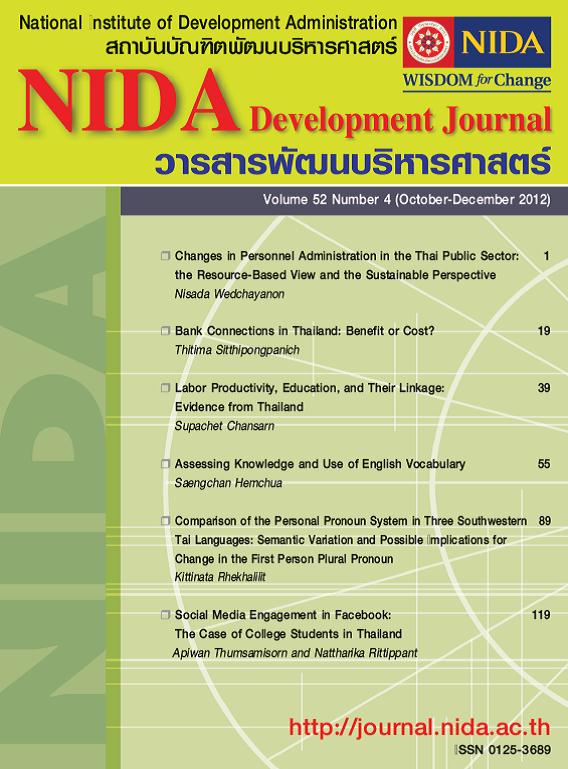Comparison of the Personal Pronoun System in Three Southwestern Tai Languages: Semantic Variation and Possible Implications for Change in the First Person Plural Pronoun
Keywords:
Tai Lue Xishuangbanna, Personal Pronoun, Componential AnalysisAbstract
Abstract
Tai Lue is a Tai language spoken by an ethnic group called the Lue, mostly found in southern parts of China, some parts of Laos, and the Northern parts of Thailand. This present study aims at analyzing the personal pronoun system spoken among Tai Lue native speakers in the Xishuangbanna Autonomous Prefecture of Yunnan Province of China, hereafter TLX. The study is based on in-depth sociolinguistic interviews of six Tai Lue informants, along with observation and field notes of the researcher. All informants use Tai Lue as their vernacular and may use Mandarin Chinese as their official language. The study reveals 12 personal pronouns, including one plural prefix /mu&u/. In addition, two main groups of semantic features were found as follows: 1) grammatical features, namely person and number, and 2) social factors, divided into two groups: inherent features, namely gender and status; and interpersonal features, namely relative status, deference, and intimacy. The data analysis also shows that the register of person deixis of the TLX personal pronoun system reflects the hierarchical society of the speaker. In conclusion, this analysis provides insight into the complicated TLX personal pronoun system through the use of the componential analysis method. Furthermore, the pronoun variation in three Southwestern Tai languages was compared to show the different usage of personal pronouns and a possible changing path of personal pronoun use in Tai languages is implied.
บทคัดย่อ
ไทลื้อเป็นภาษาตระกูลไทที่พูดโดยกลุ่มชาติพันธุ์ ลื้อ ซึ่งสามารถพบได้มากในทางตอนใต้ของประเทศจีน บางภูมิภาคในประเทศลาว และหลายจังหวัดทางภาคเหนือของประเทศไทย การศึกษาครั้งนี้มุ่งที่จะศึกษาองค์ประกอบทางความหมายของระบบบุรุษสรรพนามในภาษาไทลื้อ ที่พูดในเขตสิบสองปันนา จังหวัดยูนนาน ประเทศจีน โดยกลวิธีที่ใช้มาจากการสัมภาษณ์ทางภาษาศาสตร์สังคมและจากการสังเกตรวมถึงการจดบันทึกของผู้วิจัยเอง ผู้วิจัยสัมภาษณ์ผู้บอกภาษาจำนวนหกคน มีอายุระหว่าง 45 ถึง 71 ปี โดยผู้บอกภาษาต้องใช้ภาษาไทลื้อเป็นภาษาท้องถิ่นแต่อาจใช้ภาษาจีนกลางเป็นภาษาราชการได้ จากการวิเคราะห์ข้อมูลผู้วิจัยพบว่า บุรุษสรรพนามในภาษาไทลื้อสิบสองปันนามีทั้งสิ้น 12 คำ และมีหน่วยคำอุปสัค (prefix) พหูพจน์ 1 หน่วยคำ ได้แก่ /mu&u/ นอกจากนี้จากการวิเคราะห์ ผู้วิจัยยัง พบว่าบุรุษสรรพนามในภาษาไทลื้อมีองค์ประกอบทางความหมายหลักสองประเภทได้แก่ 1) องค์ประกอบทางไวยากรณ์ อันได้แก่ บุรุษและพจน์ ส่วน 2) ปัจจัยทางสังคม ประกอบด้วย ลักษณ์ประจำตัวผู้พูด ได้แก่ เพศและสถานะ และลักษณ์แสดงความสัมพันธ์ระหว่างผู้ร่วมสนทนา ได้แก่ ความสัมพันธ์ที่เกี่ยวข้อง ความเคารพ และ ความสนิทสนม ยิ่งไปกว่านั้น จากการวิเคราะห์ข้อมูล ระบบบุรุษสรรพนามในภาษาไทลื้อสิบสองปันนา ยังสะท้อนให้เห็นสังคมลำดับขั้นในชุมชนภาษานี้อีกด้วย นอกจากนี้ผู้วิจัยยังได้เปรียบเทียบรูปแปรของบุรุษสรรพนาม /raw/ หรือ /haw/ ในสามภาษาตระกูลไทตะวันตกเฉียงใต้เพื่อแสดงให้เห็นความแตกต่างของการใช้และนำไปสู่การสันนิษฐานการเปลี่ยนแปลงของบุรุษสรรพนามอีกด้วย




